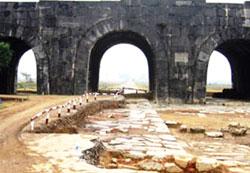Local Archeologists Discover Ancient Road in Thanh Hoa

A two kilometer-long ancient road, said to have existed in the 14th century was discovered in the central province of Thanh Hoa. The stone pathway was unearthed by local archeologists at the southern gate of Ho Dynasty Citadel, a known World Heritage Site. Extending across the gate to connect Vinh Tien and Vinh Thanh communes with Vinh Loc District in the province, is believed to have been used by Ho Quy Ly (Emperor of Ho Dynasty Emperor during 1336-1407) to travel from the inner citadel to Don Son Mountain, where he held ceremonies to heaven and earth, praying for peace and prosperity to the country and people.
Dr Tran Anh Dung, head of the excavation team from the Archaelogy Institute, claims that the unearthed road is by far Vietnam’s most beautiful ancient road. Additionally, the International Council on Monuments and Sites (ICOMOS) included the discovered pathway into the heritage listing as the most imposing, spectacular road in Southeast Asia.
The excavation project in an area of 1500 square meter around the site is expected to unearth the citadel’s original road and base. The Vietnamese archaelogists also expect to unearth three-span, five-span and seven-span abutments around 100 meters away from the southern gate. Several artifacts were also excavated including ancient weapons crafted from stone and iron along with ceramic items dating back to the Le Dynasty (1428-1528).
Perhaps among the most important things they wish to uncover are answers to several historical puzzles. With the project, the team also aims to find how the emperor traveled in and out of his citadel and whether it was used as merely a military building or a royal capital in the past.
To uncover the entire underground road, they should make available a new road to facilitate transport of the locals while the entire project is ongoing. The extent of the digging will reach both sides of the gates and structures inside the citadel. With the amount of work required, collarboration and coordination between the government and several departments should be undertaken. Though the excavation is expected to interfere with the locals’ daily activities, the end results will all be worth it, both on the tourism, historical and cultural aspect. The ancient road will then be promoted as a heritage road to protect the surrounding environment and as an added attraction to tourists.
The Ho Dynasty Citadel, located in the two communes of Vinh Tien and Vinh Long in Vinh Loc district, was built in 1397 and was recognized by UNESCO as a World Cultural Heritage on June of 2011. In September of the same year, a rock site of around 25,300 hectares at the An Ton mountain area in the province's Vinh Loc District was discovered as an excavation site used for constructing the citadel, which is nearly two kilometers away. With Thanh Hoa cradling so many historical landmarks, and looks like more are to be uncovered, the province is expected to invite more recognition, and visitors.









